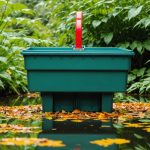Installing a greywater system can transform your garden into a sustainable oasis. This eco-friendly irrigation solution not only conserves water but also promotes healthy plant growth. Many gardeners are unaware of the simple yet effective steps involved in setting up such a system. By reusing water from your home, you can reduce your environmental footprint and save on utility bills. Discover how to install a greywater system that benefits both your garden and the planet in this comprehensive guide.
Overview of Greywater Systems
Greywater systems are an innovative solution for eco-friendly irrigation and sustainable gardening. These systems recycle water from household activities, such as bathing and washing, for use in gardens and landscapes. By doing so, they help conserve water and reduce the demand on freshwater resources. There are various types of greywater systems, ranging from simple manual systems to complex automated setups. Each type offers unique benefits and can be tailored to fit the needs of different gardens.
Dans le meme genre : Ultimate Guide to Safeguarding Electrical Outlets for Kids in Your UK Home
The importance of greywater systems in sustainable gardening cannot be overstated. They allow gardeners to reuse water efficiently, reducing overall water consumption. This not only benefits the environment by conserving precious water resources but also supports healthier plant growth. By providing a consistent source of water, greywater systems help maintain soil moisture levels, promoting robust plant development.
For gardeners and the environment alike, the benefits of greywater systems are manifold. They contribute to water conservation, reduce the strain on municipal water supplies, and lower water bills. Additionally, these systems encourage the adoption of sustainable practices, making them an essential component of any eco-friendly gardening strategy. Embracing greywater systems is a step towards a more sustainable future.
A découvrir également : Ultimate Guide for UK Homeowners: Designing an Efficient Backyard Composting System for Household Waste
Regulations and Guidelines in the UK
Navigating UK regulations for greywater systems is crucial for ensuring compliance and efficient operation. The UK has specific greywater usage laws that govern the installation and use of these systems. These laws are designed to protect public health and the environment.
Key Legislation
In the UK, the Water Supply (Water Fittings) Regulations 1999 play a significant role. They stipulate that any system must prevent contamination of the public water supply. This means that greywater systems must be designed to avoid cross-connections with potable water systems.
Compliance Considerations
Compliance involves several key considerations:
- Installation standards: Systems must be installed by qualified professionals to meet safety and hygiene standards.
- Treatment requirements: Greywater must be treated to a certain standard before use, especially if it’s used for irrigation.
- Maintenance protocols: Regular maintenance is essential to ensure ongoing compliance and system efficiency.
Resources for Permits and Approvals
To obtain necessary permits, contact local water authorities. They provide guidance on the required documentation and approvals. Additionally, consulting with environmental agencies can offer insights into the latest greywater usage laws and compliance tips. These resources ensure that your system aligns with all relevant regulations.
Planning Your Greywater System
When embarking on greywater planning, the first step is to assess your garden layout and available water sources. Understanding the topography of your garden and identifying areas that require regular irrigation can help in designing an effective irrigation layout. This ensures that the recycled water reaches all necessary areas without waste.
System design is crucial and should be tailored to your garden's specific needs. Consider the types of plants you have, as different species may have varying water requirements. Additionally, the soil type and climate can influence how you design your greywater system. A well-thought-out design maximises water efficiency and supports healthy plant growth.
Factors such as system placement and efficiency are vital for optimal operation. Place the system where it can easily connect to water sources like bathrooms or kitchens. Ensure that the greywater system is installed at a gradient to facilitate natural water flow, reducing the need for pumps. Efficient placement minimises energy consumption and maintenance needs, making your system more sustainable in the long run. By carefully planning each aspect, you can create a greywater system that supports both your garden and the environment.
Necessary Tools and Materials
When setting up a greywater system, having the right greywater installation tools and materials is crucial for a smooth installation process. The following is a comprehensive materials checklist to ensure you have everything needed for building a reliable system.
Essential Tools
- Pipe cutters: Necessary for cutting pipes to the required length.
- Wrenches: Useful for tightening and securing fittings.
- Drill and drill bits: Required for making holes in walls or fixtures.
- Screwdrivers: Handy for assembling components and securing parts.
List of Materials
- Pipes and fittings: Essential for directing greywater from source to garden.
- Filters: To remove debris and prevent clogs in the system.
- Storage tanks: For collecting and storing greywater before use.
- Valves: To control water flow and prevent backflow.
Eco-Friendly Recommendations
Opt for eco-friendly materials to enhance the sustainability of your system. Consider using recycled plastic pipes and tanks, which are both durable and environmentally friendly. Additionally, choose non-toxic sealants and adhesives to prevent harmful chemicals from leaching into the soil. By selecting sustainable materials, you contribute to a more eco-conscious gardening practice.
Step-by-Step Installation Process
Installing a greywater system requires careful planning and execution. This installation guide outlines the essential steps for a successful greywater setup.
Preparing the Site
Begin by assessing the area where you plan to install the system. Ensure that the site is accessible and has a suitable slope to facilitate water flow. Clear any debris and mark the path for pipes and other components. This preparation is crucial for a smooth irrigation installation.
Installing the Collection System
The next step involves setting up the greywater collection system. Install pipes from your water sources, such as showers or sinks, to a central collection point. Fit filters to remove impurities and prevent clogs. Position the storage tank strategically to maximise efficiency and minimise the distance to your garden.
Connecting to Irrigation
Finally, connect the collection system to your irrigation setup. Use valves to regulate water flow and ensure even distribution across your garden. Test the system thoroughly to check for leaks or blockages. Adjust the flow as needed to optimise plant hydration and system performance.
By following this installation guide, you can create an efficient and sustainable greywater system that benefits both your garden and the environment.
Maintenance and Troubleshooting
Proper greywater maintenance is key to ensuring the longevity and efficiency of your system. Regular upkeep not only prevents common issues but also maintains optimal water quality for your garden.
Routine Maintenance Tasks
Routine tasks are essential for system care. Begin by inspecting filters and pipes monthly to remove any debris that might cause blockages. This helps maintain a steady water flow. Check storage tanks for sediment build-up and clean them periodically to prevent contamination. Ensuring valves and fittings are secure will reduce the risk of leaks and maintain system efficiency.
Common Issues and How to Resolve Them
Common issues include blockages and leaks. If you notice reduced water flow, inspect the pipes for clogs and clean them as needed. Leaks can often be resolved by tightening fittings or replacing worn-out seals. Regularly check the system for any unusual noises or water pooling, which may indicate a problem needing immediate attention.
Importance of Monitoring Water Quality
Monitoring water quality is crucial for effective greywater maintenance. Regularly test the water for pH levels and contaminants to ensure it's safe for irrigation. Addressing any anomalies promptly will protect your plants and keep your system running smoothly. By adhering to these troubleshooting tips, you can ensure a reliable and sustainable greywater system.
Environmental Impact of Greywater Systems
Greywater systems offer significant environmental benefits by promoting water conservation and sustainable practices. By recycling water from household activities, these systems reduce the demand on freshwater resources, which is crucial in areas facing water scarcity. This approach not only conserves water but also supports the health of local ecosystems by reducing the amount of wastewater entering natural water bodies.
The use of greywater in irrigation helps maintain soil moisture levels, which is beneficial for plant growth. This contributes to a more sustainable gardening practice by reducing the need for additional water sources. Moreover, greywater systems can decrease the strain on municipal water supplies, lowering the overall environmental footprint of a household.
Incorporating greywater systems into daily life encourages sustainable practices that align with eco-friendly living. By opting for these systems, individuals can actively participate in water conservation efforts, playing a role in preserving local water resources. The adoption of greywater systems is a practical step towards achieving a more sustainable future, emphasizing the importance of responsible water usage. This not only benefits the environment but also fosters a culture of sustainability within communities.
Visual Aids and Resources
Understanding the installation of a greywater system can be complex, but visual aids like installation diagrams and instructional videos simplify the process. These tools provide a clear, step-by-step visual representation, making it easier for both novices and experienced gardeners to grasp the intricacies involved.
Installation diagrams are invaluable for visualising how components fit together. They offer detailed insights into the layout and connections, ensuring that each part is correctly placed. Diagrams often highlight crucial elements like pipe connections and valve placements, which are vital for system efficiency.
Instructional videos complement diagrams by demonstrating the installation process in real-time. Watching an expert assemble a greywater system can clarify any doubts and provide practical tips that are not always evident in static images. These videos are particularly helpful for understanding the nuances of system setup and troubleshooting common installation issues.
For those seeking further knowledge, there are additional resources available. Online forums, gardening workshops, and books on sustainable gardening practices offer extensive information on greywater systems. Engaging with these resources enhances understanding and equips gardeners with the skills needed to implement and maintain a robust greywater system effectively.
Common Pitfalls and How to Avoid Them
Installing a greywater system can be rewarding, yet it's not without its challenges. Installation mistakes are common, often leading to system inefficiencies or failures. One frequent error is improper pipe connections, which can cause leaks and water loss. Ensuring all fittings are secure and using quality materials can mitigate this risk.
Another common challenge is neglecting the site's topography. Installing a system without considering the natural slope can hinder water flow, necessitating additional pumps. Carefully planning the layout to utilise gravity can enhance efficiency and reduce costs.
Greywater system failures often stem from inadequate filtration. Clogged filters can disrupt water distribution, affecting plant health. Regular maintenance and selecting appropriate filters for your system's needs are crucial.
To avoid these pitfalls, thorough planning and research are essential. Understanding your garden's specific requirements and the local regulations can guide the design process, ensuring compliance and functionality. Engage with experts or resources to gather insights and tailor the system to your unique environment. By addressing these aspects, you can create a successful greywater system that operates smoothly and sustainably.












